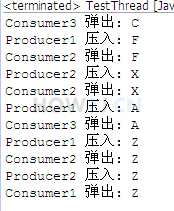| import java.util.*;
public class Test {
public static void main(String[] args){
MyStack<Character> stack = new MyStack<>();
for (int i = 0; i < 3; ++i) {
new Thread(new Producer(stack)).start();//参数为一个带有runnable接口改写了run方法的对象
}
for (int i = 0; i < 2; ++i) {
new Thread(new Consumer(stack)).start();
}
}
}
class MyStack<T> {
private LinkedList<T> list;
private int count;
public MyStack() {
list = new LinkedList<>();
count = 0;
}
public synchronized int getSize() {
return count;
}
public synchronized void push(T ele) {
while (count >= 200) {
try {
this.wait();
} catch (InterruptedException e) {
e.printStackTrace();
}
}
list.offerLast(ele);
count++;
this.notifyAll();
}
public synchronized T pull() {
while (count <= 0) {
try {
this.wait();
} catch (InterruptedException e) {
e.printStackTrace();
}
}
T res = list.pollLast();
count--;
this.notifyAll();
return res;
}
// return null if stack is empty
public synchronized T peek() {
return list.peekLast();
}
}
class Producer implements Runnable {
private MyStack<Character> stack;
public Producer(MyStack<Character> stack) {
this.stack = stack;
}
@Override
public void run() {
while (true) {
try {
Thread.sleep(100);
} catch (InterruptedException e) {
e.printStackTrace();
}
char c = generateChar();
stack.push(c);
System.out.println("Producer pushed: " + c + " " + stack.getSize());
}
}
private char generateChar() {
return (char)(new Random().nextInt(26) + 'a');//随机生成英文
}
}
class Consumer implements Runnable {
private MyStack<Character> stack;
public Consumer(MyStack<Character> stack) {
this.stack = stack;
}
@Override
public void run() {
while (true) {
try {
Thread.sleep(100);
} catch (InterruptedException e) {
e.printStackTrace();
}
System.out.println("Consumer pulled: " + stack.pull() + " " + stack.getSize());
}
}
}
|
